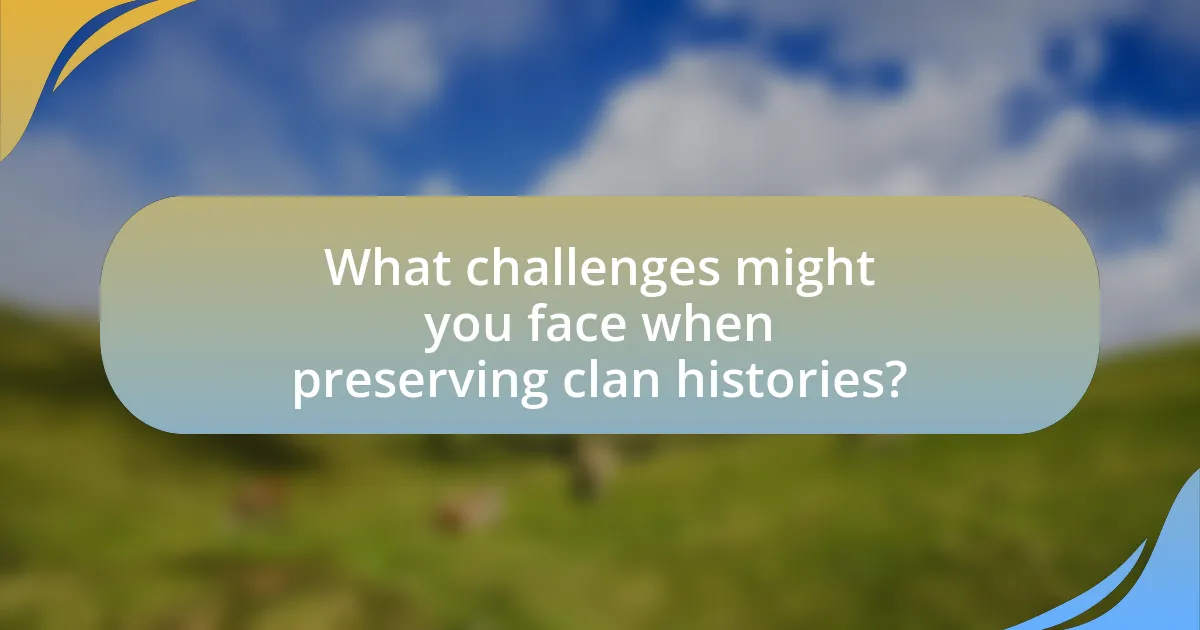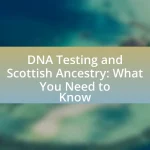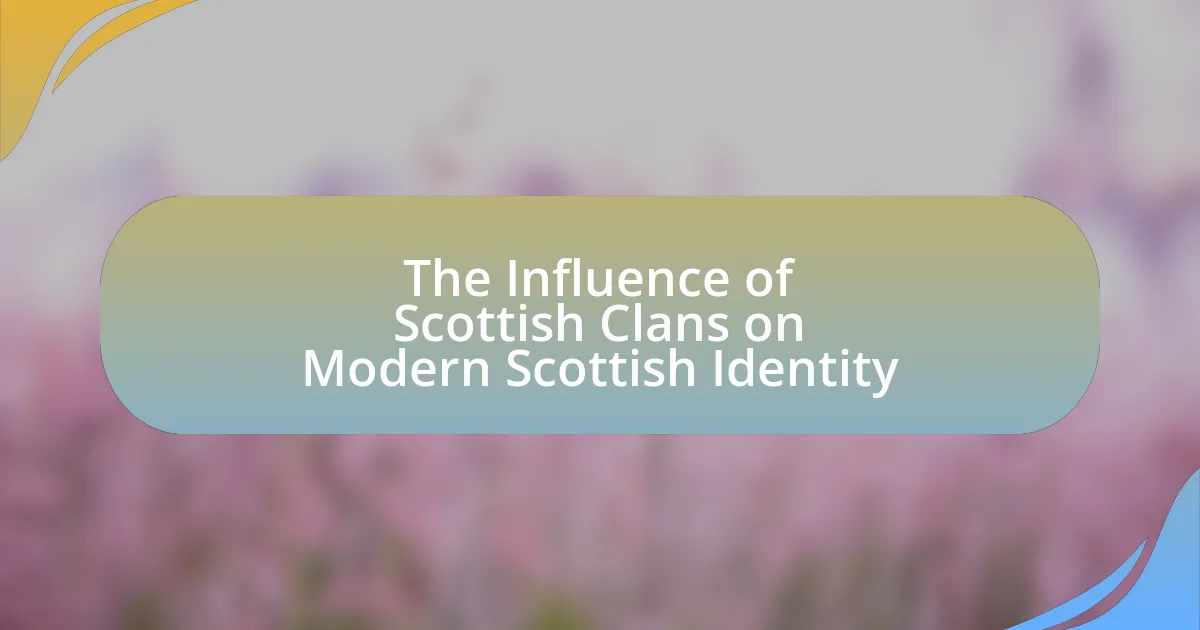The article focuses on the essential practices for preserving clan histories, emphasizing the importance of documentation, oral traditions, and community involvement. It outlines how documenting family trees enhances understanding of heritage by providing structured lineage information, while oral histories preserve personal narratives and cultural traditions. The article also discusses best practices for documenting family trees, including the use of technology and online databases, and highlights the significance of maintaining and sharing family histories to foster connections among relatives. Additionally, it addresses challenges faced in preserving clan histories and offers strategies for overcoming these obstacles.

What are the key elements of preserving clan histories?
The key elements of preserving clan histories include documentation, oral traditions, and community involvement. Documentation involves recording vital records, family trees, and historical events that shape the clan’s identity. Oral traditions are crucial as they pass down stories, values, and cultural practices from one generation to the next, ensuring that personal experiences and historical context are retained. Community involvement fosters collaboration among clan members, encouraging the sharing of resources and knowledge, which strengthens the collective memory and identity of the clan. These elements work together to create a comprehensive and enduring record of clan histories.
How can documenting your family tree enhance your understanding of your heritage?
Documenting your family tree enhances your understanding of your heritage by providing a structured overview of your ancestral lineage and cultural background. This process allows individuals to trace their roots, revealing connections to historical events, migrations, and cultural practices that have shaped their identity. For instance, research indicates that individuals who engage in genealogical research often discover significant historical contexts, such as immigration patterns or familial ties to notable historical figures, which can deepen their appreciation for their cultural heritage. By compiling names, dates, and stories, one can create a narrative that not only honors ancestors but also fosters a sense of belonging and continuity within a family or community.
What specific information should be included in a family tree?
A family tree should include names, birth dates, death dates, and relationships of family members. This information establishes clear connections between individuals, allowing for a comprehensive understanding of lineage. Additionally, including marriage dates, places of residence, and significant life events can enhance the context of each person’s life within the family structure. Accurate documentation of these details is essential for preserving clan histories and ensuring that future generations have access to their ancestry.
How does oral history contribute to clan histories?
Oral history significantly contributes to clan histories by preserving personal narratives and cultural traditions that may not be documented in written records. This form of storytelling allows clan members to share their experiences, values, and historical events, creating a rich tapestry of collective memory. For instance, oral histories can reveal unique insights into migration patterns, social structures, and significant events that shaped the clan’s identity, which are often absent from formal historical accounts. Furthermore, studies have shown that oral traditions can enhance community bonds and foster a sense of belonging, as they connect individuals to their ancestry and heritage.
Why is it important to preserve clan histories?
Preserving clan histories is important because it maintains cultural identity and heritage. Clan histories provide a sense of belonging and continuity, connecting individuals to their ancestors and shared traditions. Research indicates that communities with strong historical narratives experience greater social cohesion and resilience, as these narratives foster a collective memory that strengthens familial and communal bonds. Furthermore, documented clan histories serve as valuable resources for future generations, offering insights into ancestral experiences and lessons learned, which can guide personal and communal decision-making.
What role do clan histories play in cultural identity?
Clan histories serve as a foundational element of cultural identity by providing a sense of belonging and continuity among members of a community. These histories encapsulate shared narratives, traditions, and values that connect individuals to their ancestors and heritage. For instance, in many Indigenous cultures, clan histories are integral to understanding social structures, responsibilities, and spiritual beliefs, reinforcing the collective identity of the group. Furthermore, research indicates that individuals who engage with their clan histories often report a stronger sense of self and community, highlighting the psychological and social benefits of these narratives in fostering cultural pride and resilience.
How can clan histories foster connections among family members?
Clan histories foster connections among family members by providing a shared narrative that strengthens familial bonds. These histories often include stories of ancestors, significant events, and cultural traditions that create a sense of belonging and identity among relatives. Research indicates that families who engage in storytelling about their lineage report higher levels of emotional closeness and cohesion. For instance, a study published in the journal “Family Relations” found that children who know their family history exhibit greater resilience and self-esteem, reinforcing the idea that understanding one’s roots can enhance interpersonal connections within the family.

What are the best practices for documenting your family tree?
The best practices for documenting your family tree include organizing information chronologically, verifying facts through reliable sources, and using consistent naming conventions. Organizing information in a timeline helps to visualize relationships and events, while verifying facts ensures accuracy, which is crucial for historical integrity. Utilizing consistent naming conventions, such as standardized formats for dates and places, enhances clarity and reduces confusion. Additionally, employing genealogical software or online platforms can streamline the documentation process and facilitate sharing with family members. These practices are supported by genealogical standards set by organizations like the National Genealogical Society, which emphasize the importance of accuracy and organization in family history research.
How can technology assist in family tree documentation?
Technology assists in family tree documentation by providing digital tools that streamline the collection, organization, and sharing of genealogical information. Software applications and online platforms enable users to create detailed family trees, store historical records, and access vast databases of public records, such as census data and birth certificates. For instance, platforms like Ancestry.com and MyHeritage offer users the ability to build family trees collaboratively, allowing multiple family members to contribute information and photos, which enhances accuracy and richness of the documentation. Additionally, technology facilitates the preservation of family stories through multimedia formats, enabling users to integrate audio recordings, videos, and photographs into their family histories, thus creating a more engaging and comprehensive narrative.
What software and tools are recommended for creating family trees?
Recommended software and tools for creating family trees include Ancestry, MyHeritage, Family Tree Maker, and Legacy Family Tree. Ancestry offers extensive historical records and user-friendly interfaces, making it a popular choice for genealogists. MyHeritage provides advanced features like photo colorization and DNA integration, enhancing family history research. Family Tree Maker allows users to create detailed family trees with customizable charts and reports. Legacy Family Tree is known for its robust features and free version, appealing to both beginners and experienced users. These tools are widely recognized in the genealogy community for their effectiveness in documenting family histories.
How can online databases enhance your research?
Online databases enhance research by providing access to a vast array of historical records, genealogical data, and scholarly articles. These databases, such as Ancestry.com and FamilySearch, offer searchable collections that include census records, birth and death certificates, and immigration documents, which are crucial for tracing family histories. For instance, Ancestry.com hosts over 27 billion records, allowing researchers to uncover connections and verify lineage efficiently. Additionally, online databases often feature user-generated content, enabling collaboration and sharing of information among researchers, which can lead to new discoveries and insights into family trees.
What traditional methods are effective for documenting clan histories?
Oral tradition is an effective traditional method for documenting clan histories. This method involves passing down stories, genealogies, and cultural practices through generations via storytelling, which preserves the clan’s identity and history. Research indicates that oral histories can provide rich, detailed accounts of familial connections and significant events, often capturing nuances that written records may overlook. Additionally, clan gatherings and ceremonies serve as opportunities to share and reinforce these narratives, ensuring that the clan’s history remains vibrant and accessible to future generations.
How can family gatherings be utilized for gathering historical information?
Family gatherings can be utilized for gathering historical information by creating an environment conducive to storytelling and sharing personal experiences. During these gatherings, family members can recount anecdotes, share photographs, and discuss family traditions, which collectively contribute to a richer understanding of the family’s history. Research indicates that oral histories collected during such events can provide valuable insights into familial relationships and cultural heritage, as they often capture details that may not be documented elsewhere. For instance, the National Archives emphasizes the importance of personal narratives in preserving history, highlighting that these stories can fill gaps in official records and provide context to historical events.
What are the benefits of creating a family history book?
Creating a family history book provides several benefits, including the preservation of family stories, fostering connections among relatives, and serving as a valuable educational resource. By documenting personal narratives and historical context, a family history book ensures that future generations have access to their heritage, which can enhance their sense of identity and belonging. Research indicates that families who engage in storytelling and documentation report stronger familial bonds and a greater understanding of their lineage, reinforcing the importance of such projects in maintaining cultural continuity.

What challenges might you face when preserving clan histories?
Preserving clan histories presents challenges such as the loss of oral traditions, difficulty in verifying historical accuracy, and the impact of cultural assimilation. Oral traditions may fade as older generations pass away, leading to gaps in knowledge. Verifying historical accuracy can be problematic due to conflicting accounts and lack of documentation, making it hard to establish a reliable narrative. Cultural assimilation can dilute unique clan identities, complicating efforts to maintain distinct histories. These challenges highlight the importance of systematic documentation and community engagement in preserving clan histories effectively.
How can you overcome common obstacles in family tree research?
To overcome common obstacles in family tree research, utilize a systematic approach that includes thorough documentation, leveraging online databases, and collaborating with other researchers. Systematic documentation ensures that all findings are recorded accurately, which helps in tracking sources and verifying information. Online databases, such as Ancestry.com and FamilySearch.org, provide access to a vast array of records, including census data and immigration records, which can fill gaps in your research. Collaboration with other researchers can lead to shared resources and insights, as many individuals may have access to unique records or family stories that can enhance your understanding of your lineage.
What strategies can help you verify historical information?
To verify historical information, cross-referencing multiple credible sources is essential. This strategy involves comparing data from primary sources, such as original documents or firsthand accounts, with secondary sources like books or articles that analyze those documents. For instance, when researching a specific event, consulting government records, newspapers from that time, and academic publications can provide a more accurate picture. Additionally, utilizing databases like JSTOR or archives from reputable institutions can enhance the reliability of the information. This method ensures that discrepancies can be identified and clarified, leading to a more accurate understanding of historical events.
How can you handle conflicting information from different sources?
To handle conflicting information from different sources, prioritize verifying the credibility of each source. Assess the reliability by considering the author’s expertise, the publication’s reputation, and the presence of citations or references. For instance, academic journals and established historical societies typically provide more accurate information than personal blogs or unverified online content. Cross-reference the conflicting data with multiple reputable sources to identify commonalities and discrepancies. This method allows for a more informed understanding of the information, ensuring that the most accurate and reliable details are documented in your family tree.
What are some tips for maintaining and sharing your family tree?
To maintain and share your family tree effectively, regularly update it with new information and verify existing data for accuracy. Consistent updates ensure that your family tree reflects the most current information, while verification helps prevent the spread of inaccuracies. Utilize genealogy software or online platforms that allow easy collaboration and sharing with family members, which enhances engagement and encourages contributions. Additionally, consider creating physical copies or visual representations, such as charts or books, to share during family gatherings, fostering a sense of connection and history among relatives.
How can you effectively share your family history with relatives?
To effectively share your family history with relatives, create a comprehensive family tree and utilize digital platforms for distribution. A well-structured family tree visually represents relationships and lineage, making it easier for relatives to understand their connections. Digital platforms, such as genealogy websites or social media groups, facilitate sharing by allowing you to upload documents, photos, and stories, reaching a wider audience. Research indicates that 70% of families find digital sharing enhances engagement and interest in family history, as it provides accessible and interactive ways to explore their heritage.
What are the best practices for keeping your family tree updated?
To keep your family tree updated, regularly gather and verify new information about family members. This includes documenting births, deaths, marriages, and any changes in personal details such as addresses or names. Utilizing online genealogy platforms can facilitate this process, as they often provide tools for collaboration and data sharing among family members. Additionally, conducting periodic family interviews can uncover new stories and connections, ensuring that the family tree remains comprehensive and accurate. Regularly reviewing and cross-referencing sources, such as public records and historical documents, further enhances the reliability of the information recorded.





